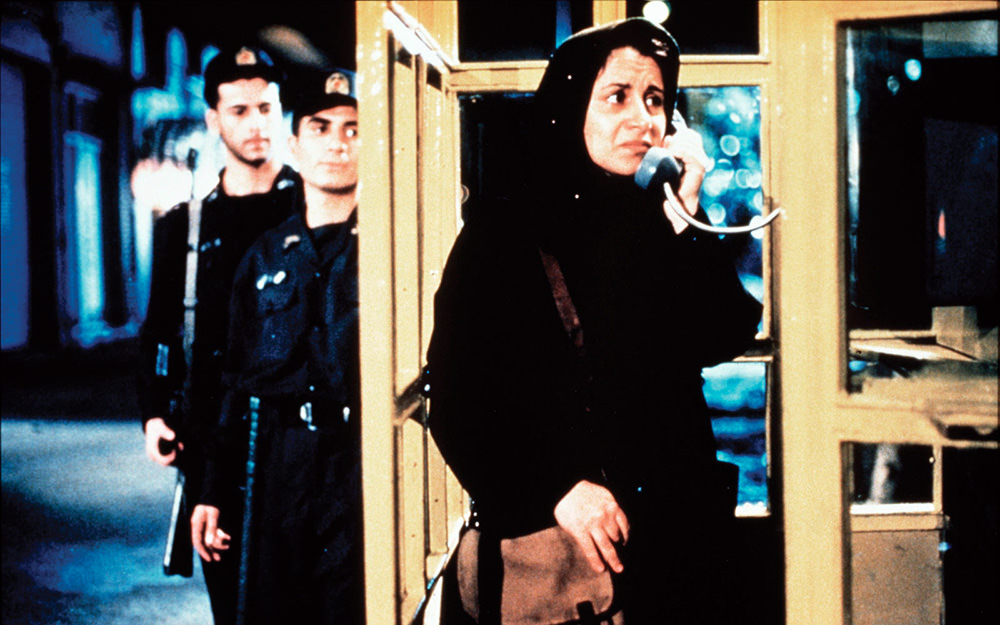The Circle by Jafar Panahi (Review)

The Circle begins with what should be a blessed event: the birth of a child. And it would be, except for one tiny problem. It’s a girl, and the mother’s in-laws were expecting a boy. And in Iran, that’s reason enough for divorce, thrusting new mother Solmaz (whom we never see) and the newborn into an uncertain future. And so begins The Circle, acclaimed Iranian director Jafar Panahi’s incisive and troubling look into the perils facing Iranian women.
The film introduces us to a number of women whose stories are loosely intertwined (one of the only joys of watching this sad film is the graceful way in which Panahi moves between their stories, regardless of how tangential they might be). When Solmaz’ mother leaves the hospital, we meet Arezou and Nargess, two women who have just been released from prison and are trying to make their way to Nargess’ home village, where they hope to start anew. When their companion is arrested (for what, we don’t know — the women’s crimes are left vague, almost implying that their real crime is simply being female), the two are left the fend for themselves with little money and even fewer friends.
We then meet Pari, whom Arezou and Nargess are attempting to contact. Pari was also an inmate, but has escaped to get an abortion. Unable to get one because her husband is dead, and having been abandoned by her family, she turns to Elham, a former inmate who has since married a doctor. However, Elham refuses to help, fearful that her husband’s family might learn of her shameful past. Abandoned once again, Pari returns to the streets and runs into Nayereh, a poor woman who has abandoned her daughter in the hopes that some wealthy family might take her in. And so it goes.
What lends the movie, already laden with emotion, even more impact is the naturalistic, pseudo-documentary manner in which it’s shot (something Iranian cinema excels at). The film takes place largely in the bustling streets and winding alleys of Tehran, and plops us right down in the middle of them. A combination of actors and non-actors also lends an authentic feel to the film (in particular, Nargess Mamizadeh, who brings a certain naivete to Nargess, making her plight all the more heartwrenching), as does the handheld camerawork.
We can barely keep up with the women as they duck and dive through Tehran’s alleys and side streets, black shrouds covering their bodies in an attempt to escape detection by the police, who have a Big Brother-like presence throughout The Circle (and given its feel, you half-expect officers to come barging in at any moment to shut the film down). Altogether, it creates a gripping sense of tension most thrillers would kill to have.
But as the film progresses, it grows less frenetic and more methodical. The camera moves less and less until The Circle ends with long, static (or extremely slow-moving) shots of characters staring off into the night. It makes for a very claustrophobic experience. As I watched The Circle, I could literally feel it constrict and crush me — and I found myself wondering, if the film is in any way accurate, how in the world these women could survive such pressure and fear on a daily basis.
There are tiny triumphs and small reliefs sprinkled throughout the film, such as when Nargess finally manages to get a bus ticket home (the fact that she’s travelling alone presents a bit of a problem) and happily buys a gift to bring back with her. And the women, forced to stick together against an oppressive system, often display extraordinary kindness and mercy to eachother. But their amazing courage and resilience won’t save them, and the film’s conclusion grows more certain with each passing moment. This is most certainly not a “We shall overcome” kind of film.
While the film’s title refers to the social circles within which the women attempt to move, it also draws attention to the structure of the film itself. The Circle’s final scene is one of the most gutwrenching I’ve witnessed in recent memory. The film comes full circle, concluding with the exact same shot that it opened with. Only instead of a hospital waiting room, the setting is a dank prison cell, and an agonizingly slow pan has revealed a few familiar faces within its walls.
Watching this shot, the camera just staring at the cell’s metal door, it’s impossible to miss the implication Panahi seems to be making, that there’s very little difference between being born an Iranian woman and receiving a prison sentence. No wonder the film was banned in Iran.
